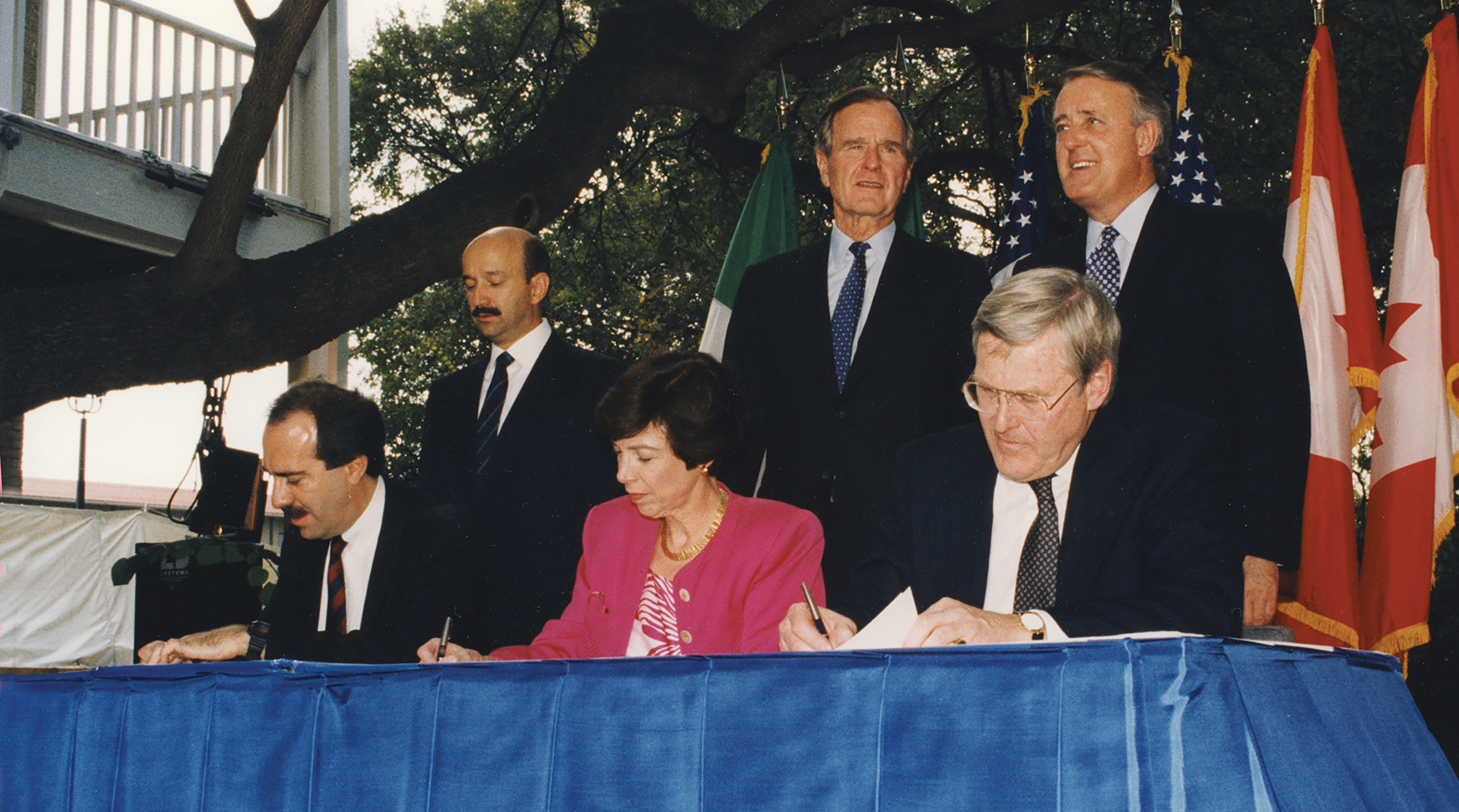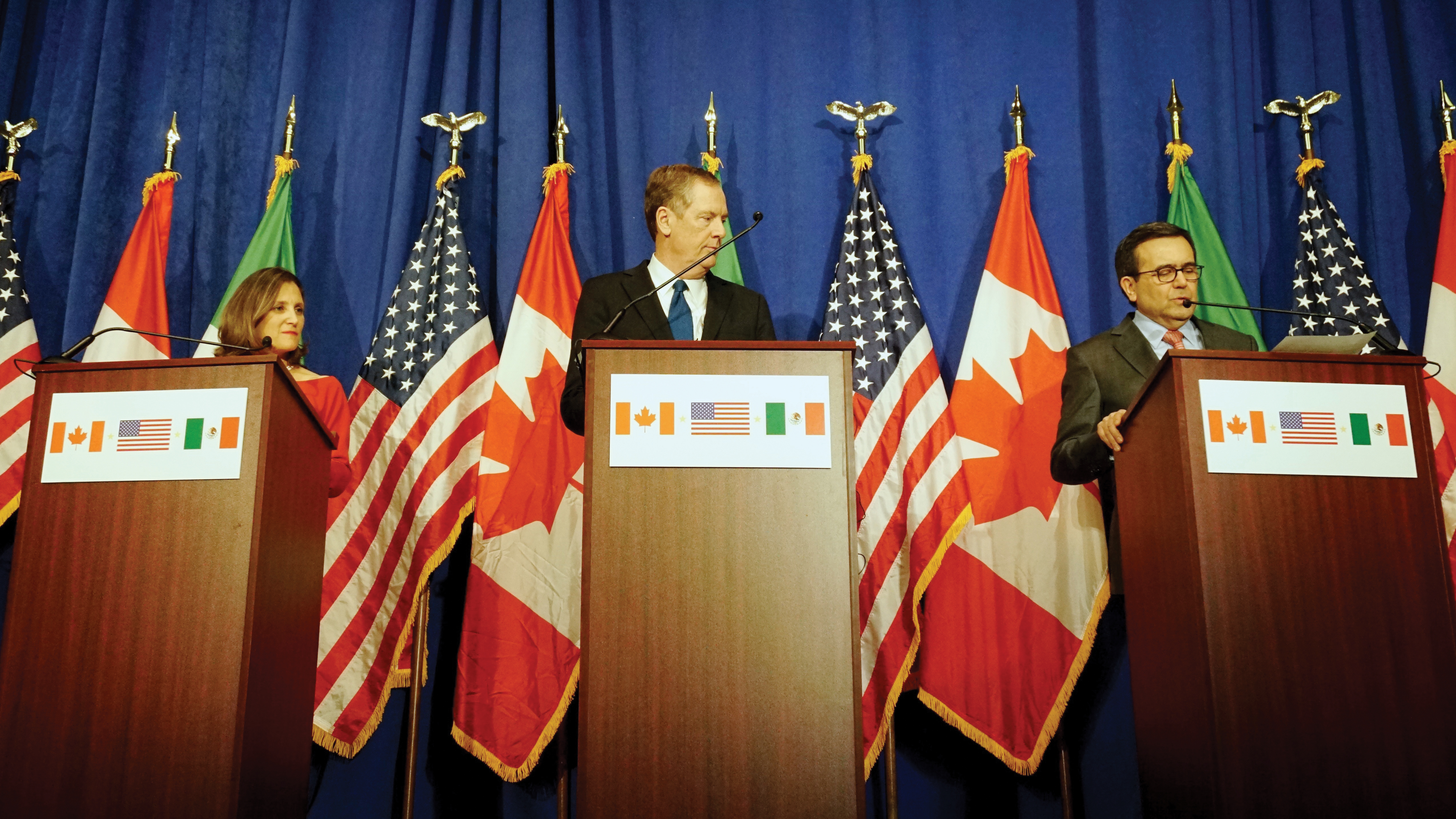How NAFTA Became the USMCA

While it has seemed since his inauguration that Donald Trump’s presidency was designed to redefine-down every norm in American policy and politics, nowhere was his disruptive potential felt more keenly by Canada than in the negotiation of an updated North American Free Trade Agreement. As a chief negotiator of NAFTA, John Weekes was particularly well-placed to observe the difference that a quarter century and one revolutionary president made to the trilateral talks.
John Weekes
The contrast between the circumstances of the original NAFTA negotiations in 1991-92 and the renegotiation over the past year could hardly be starker. Twenty-seven years ago, Prime Minister Brian Mulroney, President George H. W. Bush and President Carlos Salinas announced their commitment to enter trilateral negotiations with the objective of concluding an ambitious agreement that would eliminate or reduce to the maximum extent possible barriers to the free flow of goods, services and investment across the North American continent.
In 2017, President Donald Trump entered the White House intent on tearing up or rebalancing America’s international trade commitments. Trump and Trade Representative Robert Lighthizer did not want agreements with strong enforceable rules that fettered the capacity of the United States to use its power to bully its partners into agreeing to rebalancing the trade rules in America’s favour.
Trump had repeatedly called NAFTA the worst trade agreement ever negotiated and promised to renegotiate it or withdraw from it. Demonstrating his antipathy to trade agreements, he withdrew America from the TransPacific Partnership Agreement on his second day in office.
When the negotiations to “modernize and rebalance” the NAFTA got underway in August of last year it was unclear whether Trump’s real objective was to reach a new agreement or to press outrageous demands to ensure failure and then to withdraw from NAFTA.
Powerful and efficient North American supply chains built under 25 years of a predictable and secure NAFTA trade environment were at risk. A cloud of uncertainty stalled investment in Canada and Mexico and also, but to a lesser extent, in the U.S. Mexico was demonized by constant vitriolic rhetoric from the White House and even Canada was increasingly vilified as an alleged unfair trader.
In the first NAFTA negotiation, the leaders of the U.S. and Mexico embraced the opportunity to build a new partnership between the two countries that would put a century and a half of animosity and war behind them. Together with Canada, they saw the negotiations as an opportunity to make a stronger North America in an increasingly competitive global environment. Their vision was that the synergies of the NAFTA partnership would make each country more prosperous and better able to compete globally.
Unfortunately, these ideas were not shared by the Trump administration. For Trump it was “America First” combined with the apparent view that America was better off operating alone as it confronted new global challenges. With Trump, there was no sense that the North American partnership would help the U.S. meet the challenges posed by a rising China. In 1991, the three leaders all strongly believed that closer cooperation through trade as a win, win, win proposition. For Trump, it is a zero-sum game. If Canada or Mexico is doing well, then it must be at the expense of the U.S.
In the fall of 2017, Lighthizer put a series of poison pill proposals on the negotiating table which made it look unlikely that any reasonable accommodation could be found. In particular, the Americans came forward with proposals to:
• Sunset the NAFTA after five years unless all three countries specifically said they wanted it to continue;
• Eliminate or weaken all the dispute settlement provisions of the NAFTA to strengthen the capacity of the U.S. use its power to get what it wanted;
• Alter the rules of origin in the automobile sector to require that any automobile entering the US market would need 50 per cent US content to benefit from the NAFTA zero duty;
• Distort the government procurement aspects of the NAFTA so that the opportunities for Canada and Mexico to compete in the US procurement market would be severely reduced.
This was not a negotiation in which Trump and Lighthizer were prepared to engage in give-and-take. For them, the objective was to rebalance the NAFTA in their favour by reducing the benefits in the deal for Canada and Mexico.
Fortunately, many in the U.S. did not share Trump’s views on trade and NAFTA, including many in his own party and even in the White House. In fact, many were vehemently opposed to Lighthizer’s proposals. Canada and Mexico both conducted vigorous advocacy campaigns across the U.S. to reinforce this vein of support for NAFTA. The Canadian effort was unprecedented in its intensity and scope. This was not just a federal government effort but one that had the enthusiastic involvement of all the political parties, the provinces, cities, the business, and important elements of civil society. This was a true Team Canada approach. Canadian advocates met with their counterparts virtually everywhere in the U.S. The message spoke to the value of trade between Canada and the US. and emphasized just how beneficial trade with Canada is for American communities and workers, and how the North American supply chains make North America stronger in a global marketplace. Importantly, this message also found a receptive audience in Congress and in state capitals.

At the same time, with Trump threatening to blow up NAFTA, many Americans were conducting their own analysis about the value of NAFTA and the jobs it supports across the U.S. For years, NAFTA had become a political whipping boy but most Americans tuned out the noise and did not expect any president would seriously consider terminating the agreement. This work and analysis led a very large number of Americans to conclude that NAFTA was in fact valuable to the U.S., although they recognized that it would benefit from a dose of modernization. This awakening and mobilization of a pro-NAFTA constituency may be the most important outcome of the last two years. This constituency will remain valuable to Canadians long after Trump has left the White House.
As if to prove how valuable NAFTA was to Americans, Trump decided under Section 232 of U.S. law to apply global tariffs for phoney national security reasons on steel and aluminum imports, including from Canada and Mexico. This inevitably led to retaliation by both countries, which adversely affected many Americans, calling into question whether the president knew how to defend their interests and livelihoods. His threats to put a similar tariff on automobile imports worried Canada and Mexico but also created further unease in the U.S. Twenty-five years ago, the negotiations faced difficult moments but such bullying tactics were never deployed.
Throughout the negotiations, the Canadian team led by Prime Minister Justin Trudeau, Foreign Minister Chrystia Freeland and Chief Negotiator Steve Verheul was resolute and effective at the negotiating table, in advocacy efforts and in the public war of words.
In the original negotiations, the partnership between Canada and Mexico was an important part of the negotiating dynamic but in the recent negotiation it assumed greater importance. Of course, both countries were negotiating on behalf of their own constituencies and interests but there was sufficient commonality of interest that the outcome is better than it would have been had they negotiated alone. And in the final phase, Mexico actually enhanced Canada’s negotiating leverage by striking a separate deal with the U.S. For the first time in the negotiations, Lighthizer wanted to conclude a deal with Canada because that was the only way he could secure Congressional support for what he had achieved with Mexico. One result was that Canada was able to retain the binational panels on dispute settlement under NAFTA Chapter 19—a key objective.
Going forward into the critical period of Congressional ratification of the new U.S. Mexico Canada Agreement, and beyond, Canada and Mexico will need to continue to work closely together. Both will also need to work closely with the American pro-trade, pro-NAFTA constituency.
John Weekes, a senior business adviser at Bennett Jones LLP, was Canada’s chief negotiator for the NAFTA from 1991 to 1994.
